Subtotal: $
Checkout-

Into the Sussex Weald
-

The Abyss of Beauty
-

Let the Body Testify
-

Ernest Becker and Our Fear of Death
-

Singing God’s Glory with Keith Green
-

More Fish Than Sauce
-

Return to Idaho
-

The Glory of the Creatures
-

Poem: “The Path”
-

Poem: “The Berkshires”
-

The Secret Life of Birds
-

Why Children Need Nature
-

Made in the Image of God
-

The Lords of Nature
-

Editors’ Picks: The Opening of the American Mind
-

Editors’ Picks: Klara and the Sun
-

Writing in the Sand
-

City of Bees
-

Sister Dorothy Stang
-

Midwestern Logistical Small Talk
-

Covering the Cover: Creatures
-

Love in the Marketplace
-

The Elemental Strangeness of Foxes
-

Saints and Beasts
-

Astronomy According to Dante
-

The Book of the Creatures
-

Letters from Readers
-

Vulnerable Mission in Action
-

Community-Supported Agriculture in Austria’s Weinland
-

My Forest Education

Regenerative Agriculture
An Amish Farmer’s Quest to Heal the Land
By John Kempf and Jeff King
June 8, 2021
Regenerative agricultural practices seek to improve plant health by restoring and maintaining natural soil biology and chemistry. Ohio Amish farmer John Kempf has emerged as a leading advocate, with a podcast, webinars, and a consulting firm, Advancing Eco Agriculture. Jeff King, who applies these principles to grow vegetables for his Bruderhof community in New York, interviewed him for Plough.
Already a subscriber? Sign in
Try 3 months of unlimited access. Start your FREE TRIAL today. Cancel anytime.
Jeff King: Is regenerative agriculture just a new name for organic farming?
John Kempf: There are people seeking to come up with regenerative certifications; I hope they remain unsuccessful. Organic certification unfortunately devolved into an us-versus-them conversation where one side is good and the other is evil. I’m really glad that the conversation around regeneration still has an openness and the recognition that this is a journey, not a destination. A farmer just starting out, who has been engaged in practices that were very degrading to the land because he didn’t know any different, when he becomes aware, can begin making that transition. We should embrace that grower, welcome him, and give him the support and encouragement he needs.
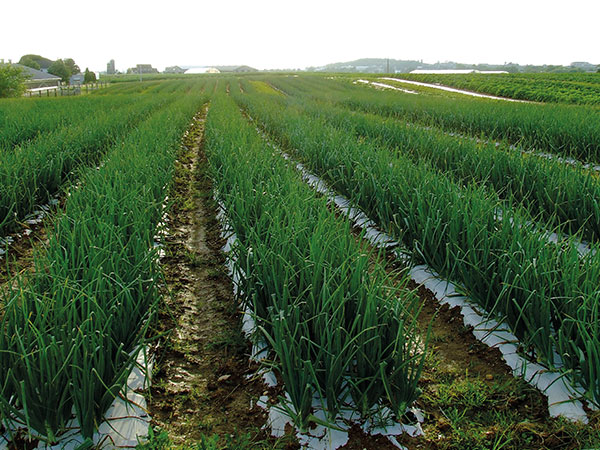
Image courtesy of Pamela Reed
You talk about the moment at which growers realize that the track they’re on is a disastrous one. Did you have that kind of experience yourself?
Yeah, I had a two-by-four-in-the-face moment, on the family fruit and vegetable farm I grew up on, about fifteen acres in the snowbelt south of Lake Erie. We would get anywhere from ninety to a hundred inches of snowfall per year, and total rainfall of thirty-eight to forty-two inches per year. I used to believe this wet environment gave our crops a predisposition to being susceptible to diseases and insects.
My dad started growing vegetables in 1996. When I finished school at fourteen, I was given the responsibility of doing all the drip irrigation and the foliar applications of fertilizers and biostimulants and pesticides. My dad was also the regional pesticide supplier; we were the first people to try all the newest pesticides and then make recommendations to farmers based on how well they were working for us. But in spite of ever-intensifying pesticide use, it became more and more difficult to control different diseases and insects. We had a three-year period, 2002 to 2004, in which we lost upwards of 70 percent of our four primary crops.
In the 2004 growing season, we rented a field from a neighboring dairy farmer that bordered one of our own fields. These two fields used to be tilled and planted up and down the slope but we switched the direction of tillage and planted the crops across the field border. On one end, we planted a crop of cantaloupe.
When we grow crops that are resistant to diseases, they also improve the health of the people and the livestock who consume these plants as food.
At harvest time, on the soil we had been farming for the prior decade with intense pesticide applications, 80 percent of the leaves were infected with powdery mildew. On the new soil, from the dairy farm with a four-year rotation of corn, small grains, and two years of hay without pesticide applications, there was no powdery mildew. Not 5 percent infection or 10 percent infection, but zero – you couldn’t find any powdery mildew in that part of the field; there was a knife-line effect right down the center. The vines were the same variety, planted the same day, same fertilizer applications, same fungicide applications, but two completely different outcomes.
I wanted to know: What are the differences? What allows one plant to be resistant to powdery mildew when the plant two feet away is susceptible? I was very fortunate to connect with several amazing mentors, and I learned a lot about plant physiology and plant immune systems – plants have an immune system much the same as we do. There’s a significant body of research describing how to manage plant nutrition to increase their immune systems and develop their resistance to diseases and insects. But what really got me started down the pathway of regenerative agriculture was the realization that when we grow crops that are resistant to diseases, they also improve the health of the people and the livestock who consume these plants as food.
You’ve claimed that healthy plants can be completely resistant to any disease or insect. That’s a pretty audacious claim.
This is not a theory. This is something that we have actually put into practice on millions of acres here in North America, very successfully. It is possible for crops to be resistant to grasshoppers, to aphids, to Colorado potato beetles, to Japanese beetles. There are obviously hundreds of diseases and insects and we haven’t worked with all of them, but we have yet to encounter one we have not been successful in treating and reversing with nutrition management, including a number of diseases for which there is no known pesticide treatment.
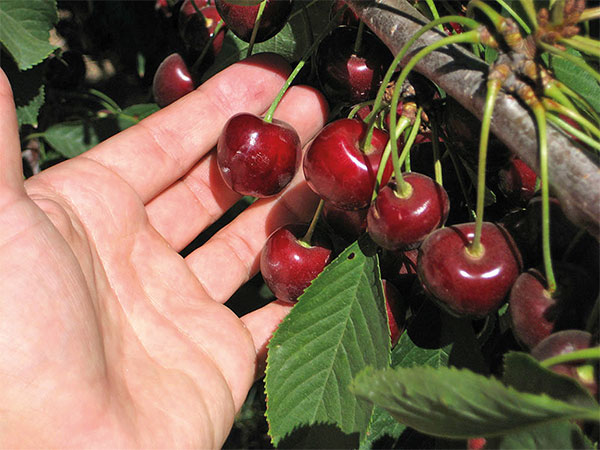
Regenerative methods work even for conventionally high-spray crops such as stone fruit.
Can you give an example of a specific farmer who has been able to do this?
Let’s talk about one of the incurable diseases. Bacterial canker on cherries is an infection where the bacteria live inside the plant’s vascular tissue, and there is no known pesticide treatment. Back in 2011, one of the preeminent cherry growers in the Pacific Northwest said to us, “I don’t care about reducing pesticides. I have no desire to reduce my fertilizer applications. And I do not want to be organic. What I really want is to grow large, firm cherries that qualify for the export market to Asia. And I’ve heard that you can help me do that.”
He gave us fifty acres of cherries to run trials on, a block of trees about five years old and so badly diseased that, if we weren’t able to turn it around in one year, they were going to take the bulldozer to it and replant. Eighteen months after we started treating the diseased trees there was no detectable bacterial canker anywhere in that block.
One of our first recommendations was that he was putting on too much fertilizer too early in the season, and we tested it. In one block of trees, half got the fertilizer, half did not. At the end of harvest season, he concluded that stopping that fertilizer application improved his profitability by $1,600 per acre. This has been one of our foundational realizations: the majority of disease and insect problems are not caused by nutrient deficiencies but by the excesses of products farmers apply.
Some people think regenerative agriculture might be less productive, but our experience has been the opposite. When you manage plant nutrition for optimal quality and health, yields increase. Our message to farmers is very simple: we can help you be more profitable by managing plant nutrition differently.
How do we profess to be stewards of God’s creation and yet have adopted a model of agriculture with such a negative impact on the creation that we are here to steward?
You’ve hinted at the concept of food as medicine, which is a very powerful thought for growers like me who want to be effective in helping people and have the biggest positive impact we can.
We have a public health crisis around the world today. We have all these degenerative illnesses such as heart disease and diabetes and stroke and cancer that, when you combine them, afflict the majority of our population. Fundamentally, I would suggest that this is a failure of agriculture to produce nutritious food that can enhance our immune systems. There’s certainly more involved than just the food we eat, but food certainly is a significant contributing factor.
All plants produce compounds generically referred to as plant-secondary metabolites. Some of these compounds whose human health benefits have been relatively well-studied would be lycopene in tomatoes, or resveratrol in red wine and watermelons, or anthocyanins in blueberries. The piece that has been missed is that the concentrations of these compounds within plants vary dramatically based on the plant’s health. In 1992, Michigan State University conducted research and found that the anthocyanin content of blueberries can vary by a factor of twenty-five.
We’ve also forgotten what really good food tastes like. Can you imagine the flavor and the aroma differences between blueberries that have twenty-five times variability in anthocyanin content? The same is true if you’re speaking about tomatoes or spinach or strawberries. Even when we grow our own fruits and vegetables in our gardens, unless we address nutrition management and specifically seek to grow nutrient-dense, high-quality fruits and vegetables, most of us have no idea what really healthy fruit and vegetables actually taste like.
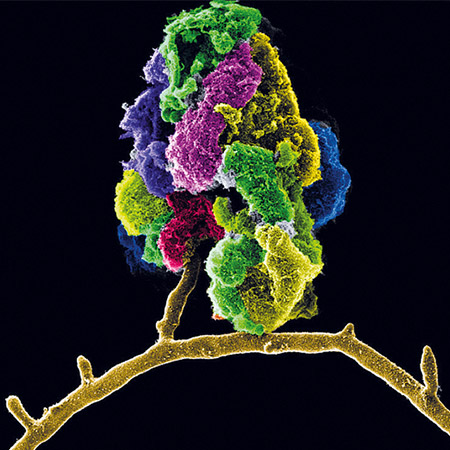
Healthy soil hosts a beneficial community of bacteria, fungi, and other microscopic organisms. Helium ion microscopy by Shuttha Shutthanandan, Pacific Northwest National Laboratory.
When I watched one of your webinars for Midwestern corn and soy growers, I was surprised to hear you quoting Genesis and Job.
Modern farming adopted a model of agriculture that is very degrading of our ecosystems, one that has contributed tremendously to a loss of topsoil, a loss of nutritious food, a loss of water quality. You think about that from a Christian perspective and you ask, “How do we profess to be stewards of God’s creation and yet have adopted a model of agriculture with such a negative impact on the creation that we are here to steward?”
I came to the conclusion that this revolves around two incorrect beliefs. The first is that we are here to have dominion over the earth, a common translation of the Hebrew in Genesis. In modern English, “dominion” implies domination and subjugation. But the original intent is clearly to communicate that we have a responsibility to steward God’s creation.
The second belief is that the earth is cursed. We don’t even have to go into the New Testament and the act of salvation to refute this. We simply have to look at Genesis 8:21. After Noah emerged from the ark, God smelled his burnt offering and said, “Never again will I curse the ground because of humans, even though every inclination of the human heart is evil from childhood.” So if we embrace the promises God has given us, we can adopt a model of agriculture that avoids pestilences and plagues, diseases and insects and weeds. Ultimately, if we believe that the land is cursed, then it will be – but it doesn’t have to be.
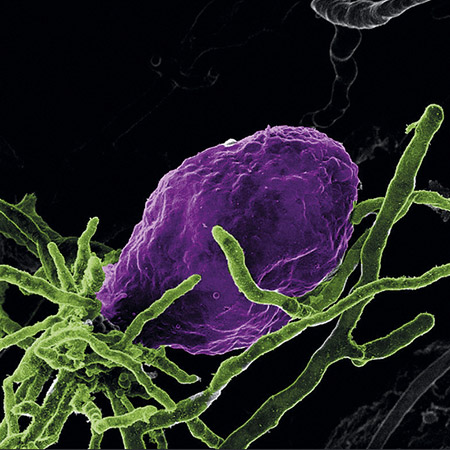
Each spoonful of soil contains up to one billion of these microorganisms, which are essential to plant growth. Helium ion microscopy by Shuttha Shutthanandan, Pacific Northwest National Laboratory.
We see the language of warfare being applied in agriculture, even “nuking” pests or weeds. So yours is perhaps a more nonviolent approach to farming?
You’re absolutely right. We have chemicals called Panther and Prowl and Warrior, based on this mentality of search and destroy – if the first weapon of choice is not successful, simply get a bigger bomb. This is not an ethos of stewardship. Job 5:23 comes to mind: “For you shall have a covenant with the stones of the field, and the beasts of the field shall be at peace with you.” We should work in alignment with the minerals and the nutrients that give us abundant plant nutrition and quality, because that is what gives resistance to drought and the resilience to continue to produce crops in very challenged environments. A covenant is not a one-sided relationship. And farmers want to do the right thing. No farmer has ever got out of bed in the morning and thought, “What can I destroy today?”
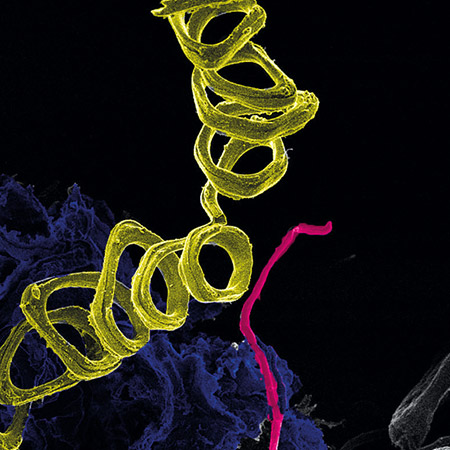
Scientists are only beginning to understand the complex relationships within this microbiome. Helium ion microscopy by Shuttha Shutthanandan, Pacific Northwest National Laboratory.
It seems a lot of these farmers are specializing in one crop. Should we be moving away from this kind of monoculture and toward more diversity in our planting? Might the relationship between crops and livestock be part of that?
I do believe it’s good to incorporate livestock back into the landscape. That step can be more effective at regenerating ecosystems than almost anything else. We also need to develop regionalized and decentralized food and agricultural systems. I don’t think it’s healthy from a national food-security perspective that 45 percent of our entire fruit and vegetable supply in North America is produced in three counties in California. We once had vibrant fruit and vegetable production throughout the Midwest. The Great Plains have some of the most fertile soils on the globe. Are we really going to use those incredible, beautiful, fertile soils to produce ethanol?
Would you agree that a farm’s fertility should be maintained from within the farm’s borders?
In concept, yes. There should be fewer fertilizer and pesticide inputs from such external sources as mined fertilizers. But what if your operation is a one-and-a-half-acre market garden? You don’t have room for livestock. The resources to maintain and regenerate soil fertility should still come from the local ecosystem, but that can be from a local livestock farmer producing compost.
Another principle of regenerative agriculture is reducing tillage. For growers I know, that’s one of the biggest hurdles. Is it necessary to go completely no-till?
I dislike the way this conversation has been framed – it’s these binary, polar opposites, good and bad, black and white, and it’s not that simple. Indigenous populations have been growing potatoes for thousands of years in the Andes; those soils have been tilled continuously and they are not degrading. We have to look at the net balance, not just one single factor. So if tilling might have a negative impact, then what are we doing to counterbalance that impact? Are we growing cover crops? Are we adding compost and microbial inoculants and biostimulants?
That being said, I am an advocate of reducing or eliminating tillage. There has been incredibly successful innovation on smaller farms, but it doesn’t always transfer well to fifty acres or five hundred acres. We desire to develop an agriculture over time that is more regionalized, more decentralized, more scale-appropriate. In the meantime, we have to recognize the reality that exists today, where seven thousand fruit and vegetable growers in the United States produce 90 percent of the total domestic supply chain – we need to develop regenerative systems that can be executed successfully on thirty thousand acres of carrots.
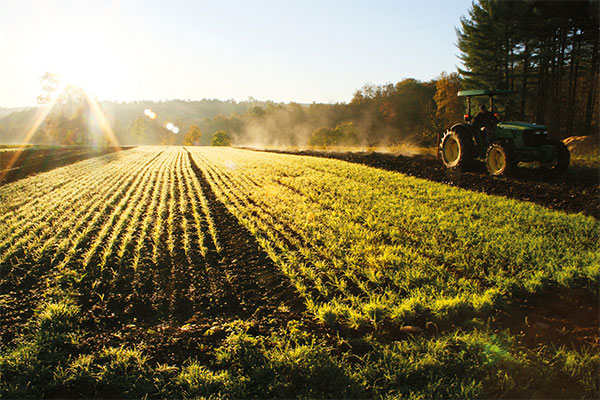
Cover crops such as the winter rye in this canteloupe field form a key part of the regenerative approach. Photograph by Darius Clement. Used by permission.
You’re saying what will drive change is economic interest. What about consumer demand?
Consumer demand does not determine what arrives at the supermarket shelf. If it did, there would be no tomatoes that tasted like cardboard and no strawberries that were picked half-green! What determines what arrives at the grocery store is the processors and distributors. Farmers also do not desire to grow cantaloupe that tastes like a rock. They enjoy growing flavorful food.
Have you experienced opposition from corporations with a vested interest in the status quo?
Actually, we now have CEOs of large ag-chemical corporations talking about how they will be helping farmers adopt regenerative agriculture practices. It’s debatable how real that is, but at least they recognize that this movement is too significant to squash.
I see myself as providing information to the people who really hold the power to change the way agriculture is done – the farmers themselves. Farmers can make the choice to discontinue pesticide and fertilizer applications, and if they do, suppliers are largely powerless to change them.
It’s not beneficial to be anti-Monsanto, anti-GMO, anti-Roundup, because the moment you take a position, you immediately alienate all the people who are currently using those tools and technologies. That limits our ability to facilitate a transition. When we talk about having empathy with plants and livestock and ecosystems and the land, that also extends to having empathy with people who have a different perspective, who might be the “them” in “us-versus-them.” The more successful we are at approaching dialogue from a place of love and understanding, the more successful we will be at creating systemic change.
Interview conducted February 4, 2021.
Already a subscriber? Sign in
Try 3 months of unlimited access. Start your FREE TRIAL today. Cancel anytime.










































Grace M
Your insights into regenerative agriculture are eye-opening! It is amazing to see how your approach not only benefits crops but also supports healthier ecosystems.
Hans-Peter Lang
„How do we profess to be stewards of God’s creation and yet have adopted a model of agriculture with such a negative impact on the creation that we are here to steward?” I fully agree to John Kempf and I also see changes in agriculture (and in forestry) as the essential step to improve the health of our ecosystems worldwide – including the health of mankind. Due to an excellent teacher in forest ecology during my studies decades ago I never forgot some questions he recommended to put when we would look around in a definite forest stand: Who are you? Where do you come from - which was your developing process? In which direction do you go (will this stand develop)? This means for me I have to see this forest as a specific part of God’s creation, often very much influenced by clear cuts of my ancestors, perhaps degraded, growing on a specific site and soil, having a specific natural vegetation type etc. It is an individual and looking after its history does show me much. In this way I am developing a relationship. For me such a relationship to a piece of forest land is the key to find the right steps for any kind of tending, harvesting steps, looking after natural regeneration, choosing the species of trees to be planted etc. A personal relationship to Jesus is the key to become a real disciple of Christ. A personal relationship to the land which has been entrusted to me as a farmer or forester seems to me essential to treat it in the best way – for me and for the future generations. I am appointed as a ruler over God’s creation (Gen.1, 26-28) but every ruler who as a king does not have a relationship and some love to his people will be become an exploiting ruler and not a steward (Gen.2,15).
Jacqueline Watson
I was very interested in John Kempf's piece and the state of farms that some landowners are sucking the life out of for the sake of profit. Prince Charles in this country was ridiculed when he started Organic Farming, he is now one of a few farmers making a profit but not at the expense of the land and more people are taking his methods on board.
Alfred DuBois
It was great to see this article in the Plough Quarterly - and I immediately shared it with someone from Church who is a subsistence farmer. He grows wonderful food and brings it to us every Sunday at Church. Hopefully we will both be able to visit one of the communities to see Community Life in action in the near future. I am now 63, the spirit is willing, but the body is weak. The article also brought black many memories for me, I went to SUNY Ag & Tech during the early 80's and my dream was to be involved in some type of farming or community life...At the time, my mentor was a Homesteader who is still alive and in his 80's he lives in Oxford, NY. He and his wife were instrumental during the 60's and 70"s to all the natural movements: back to the land, homesteading, homebirth, home education, herbalism and many, many more topics.. He had twelve children on the homestead, no car, no refrigeration - however he was able to draw thousands to his conferences and influenced so many through his letter writing and various outreach programs. The article also brought back memories to me of all the farming monasteries that I visited, and how impressive they were to me not only of "sustainable" regenerative agriculture, but also the prayer life and the psalms... It also made me remember all the good books that I had read in this same spirit, Thoreau, Helen and Scott Nearing, Ten Acres Enough, Two Acre Eden-Gene Logsdon, 5 acres and Independence, The Church and Farming, The Church and the Land, the writings of Belloc and Chesterton - relating to Distributism; and also the writings of Peter Maurin of the Cathoilc Worker Movement.. It was a great article. I hope to see more of it and more people drawn back to the land-to achieve good food, and a development of community life.
LUZ LOPEZDEE
I believe we have to turn to scripture that says, Good soil produces good fruit...thus let us diligently learn how to turn the dead soil into GOOD SOIL...that is regenerative ...there is a movie NEED TO GROW...that has some very good points... May the good Lord lead us to the right way to make the soil good again.
John Scott
When I read Kempf’s article on regenerative agriculture, I immediately emailed it to my grandson who is just getting started in agriculture (he had a rather unfortunate experience with pigs in college and lost a bit of money). It turns out he was reading on the same topic. We had a good chance to share ideas and I wanted to encourage him in this area. I recommended Wendell Berry’s writings. As a retired American History teacher I am well aware of how our abuse of the land, especially on the great plains as well as in the cotton south, has diminished our inheritance. Now, faced with floods in some areas and drought in others, perhaps we are being forced to adapt to save what we do have left.
Martin Steinbereithner
The article, but even more so the interview with John on the podcast was revolutionary for me. I am not very much up on such matters, but this really grabbed my attention and made me listen up. I am grateful for this perspective which is so different from what you usually hear, and it makes me want to pursue this topic further, since I believe I have a responsibility to do so as a Christian. So thanks a lot for your work on this!
Susan Barbarisi
Excellent and most encouraging article. The Hudson Valley is a great place to practice regenerative agriculture on small farms. And a very good point about not getting into the us-and-them mentality. My impression is that farmers do love their land and farming and want to do what's best, but they'd also like to pay their taxes and bills and hold onto their land! They need all the help and encouragement and reliable and truthful information they can get to do so. Thank you so much for this article.